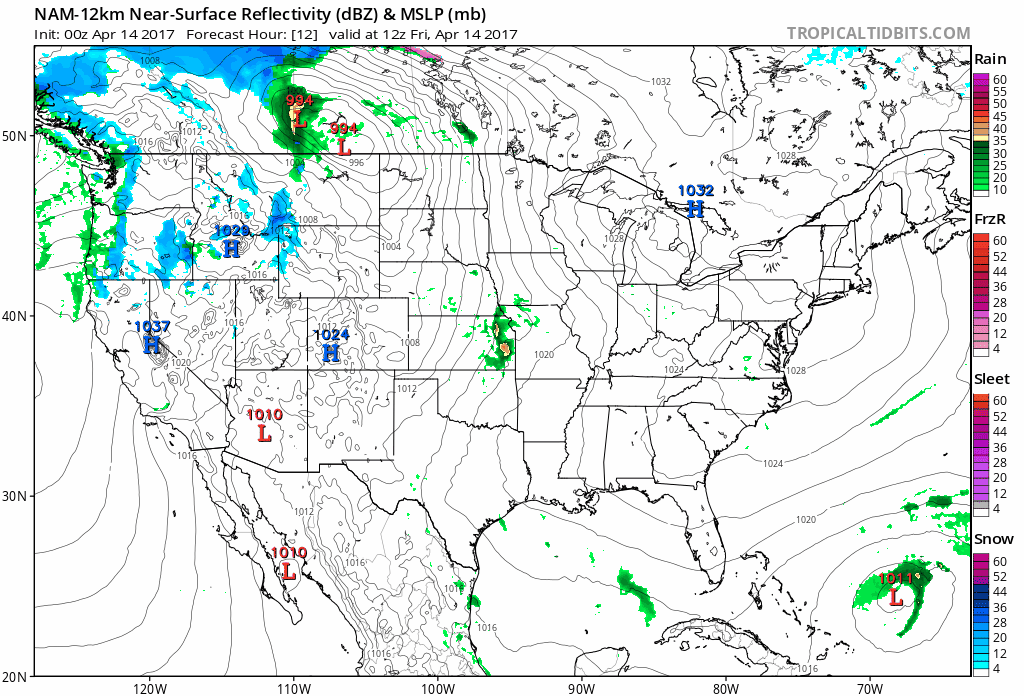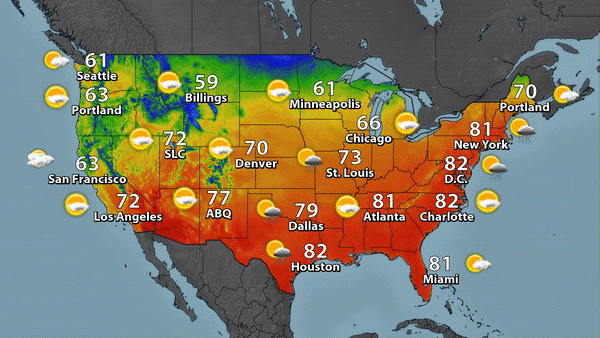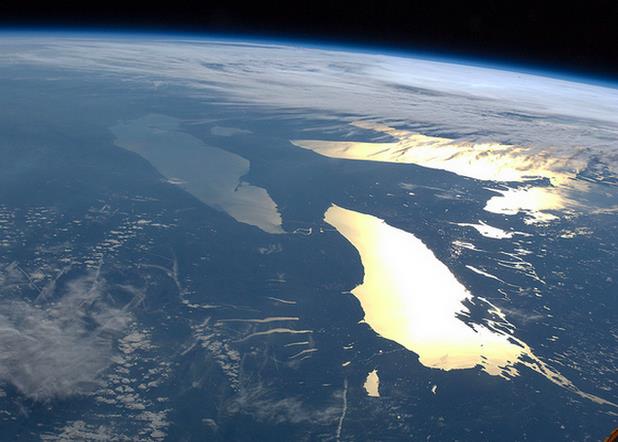55 F. high temperature in the Twin Cities on Thursday.
57 F. average high on April 13.
71 F. high on April 13, 2016.
April 14, 1983:
A 'surprise' snowstorm covers east central Minnesota. The Twin Cities
receives 13.6 inches, the all-time record for April. Brilliant blue
skies and bright sun appear the next morning.
April 14, 1886: The deadliest tornado in Minnesota's history rips through St. Cloud and Sauk Rapids, leaving 72 people dead. 80 percent of all buildings in Sauk Rapids would be leveled as the tornado's width expanded to 800 yards. As it crossed the Mississippi it knocked down two iron spans of a wagon bridge and local witnesses said the river was 'swept dry' during the tornado crossing. 300,000 dollars damage would occur in Sauk Rapids, only 4,000 dollars of which was insured. The forecast for that day was for local rains and slightly warmer with highs in the 50's.
April 14, 1886: The deadliest tornado in Minnesota's history rips through St. Cloud and Sauk Rapids, leaving 72 people dead. 80 percent of all buildings in Sauk Rapids would be leveled as the tornado's width expanded to 800 yards. As it crossed the Mississippi it knocked down two iron spans of a wagon bridge and local witnesses said the river was 'swept dry' during the tornado crossing. 300,000 dollars damage would occur in Sauk Rapids, only 4,000 dollars of which was insured. The forecast for that day was for local rains and slightly warmer with highs in the 50's.
Situational Awareness: "Doppler In Your Pocket"
We still can't DO anything about the weather but at least we can see those red blobs coming, like never before. Weather information, even Doppler radar, has been democratized - now you can track storms on your TV, your PC, your gaming device and hundreds of weather apps for smartphones, many of them free.
Unless you're wandering the Boundary Waters Canoe Area there is NO reason why you should be surprised by bad weather.
Traditional media (TV, radio and print) can give you context, perspective and analysis no app will ever provide. But when you're on the golf course or sitting at Target Field and you need a nugget of information NOW, there's no substitute to checking Doppler on your phone. Over time you'll save time, money and aggravation -staying safer in the process.
More showers push into Minnesota today; even a few claps of thunder tonight and Saturday. Sunday looks like the sunnier, drier day of the weekend with enough blue sky for low 60s.
More heavy showers and T-storms arrive next Tuesday, but I don't see a big risk of hail or high water anytime soon. Enjoy the quiet.
Saturday Severe Risk. A relatively quiet Friday gives way to a better chance of large hail, damaging winds, even an isolated tornado or two from the Texas Panhandle to Wichita and Kansas City Saturday. Map credit: NOAA SPC.

Relatively Quiet for Mid-April. Showers and embedded thundershowers lift across the Midwest into the Great Lakes, reaching New England late Saturday and Sunday - while the Pacific Northwest gets a brief break from the puddles and snow finally tapers to flurries across the Rockies. Mother Nature is only catching her breath - it still looks like an extra-active and severe spring across much of the USA. 12 KM NAM guidance: NOAA and Tropicaltidbits.com.

Easter Sunday Preview. Much of the southern and eastern USA will look and feel more like mid-May with 70s and 80s. Showery rains are likely across the Plains, but no widespread severe weather outbreaks are imminent. California and the Pacific Northwest will even get a break with some badly needed sunshine! Graphic credit: Praedictix.
45 Separate Atmospheric Rivers During Record West Coast Wet Season. And we're not done just yet, looking at the pattern and the maps. Here's an excerpt from the Center for Western Weather and Water Extremes: "...There
have been 45 total atmospheric rivers that have made landfall over the
U.S. West coast from 1 October to 31 March 2017. Of the 45 total ARs, 10
have been Weak, 20 have been Moderate, 12 have been Strong, and 3 have
been Extreme (Based on IVT magnitude). 1/3 of the landfalling ARs have
been “strong” or “extreme”. The large number of ARs that have made
landfall over the U.S. West Coast have produced large amounts of
precipitation. The Northern Sierra 8-station index is currently at 83.4
inches, which is just 5.1 inches below the wettest year on record with
seven months remaining in the water year. The graphic below, from the
California Department of Water Resources, highlights this information..."
From Extreme Drought to Record Rain: Why California's Drought-to-Deluge Cycle is Getting Worse. Exhibit A for "weather whiplash". Here's a clip from The Los Angeles Times: "...The
dry periods are drier and the wet periods are wetter,” said Jeffrey
Mount, a water expert and senior fellow at the Public Policy Institute
of California. “That is consistent with what the climate simulations are
suggesting would be a consequence for California under a warming
planet.” Warming global temperatures can have a profound effect on
weather patterns across the planet. Changing the distribution of warmth
in the ocean drives changes in the atmosphere, which ultimately decides
how much precipitation gets to California, Mount said. Warm weather
worsened the most recent five-year drought, which included the driest
four-year period on record in terms of statewide precipitation.
California’s first-, second- and third-hottest years on record, in terms
of statewide average temperatures, were 2014, 2015 and 2016..."
Map credit: "Snow everywhere: Sierra snow totals." (National Weather Service).
California Overcame 1 in 100 Odds to Beat Its Epic Drought. WIRED has the details.
Photo credit: "The Mt. Washington Auto Road Stage Office, where the Observatory was first established, with an anemometer mounted on the roof and thermometer housing mounted on the northern exterior wall."
More details on the April 21, 1967 tornado outbreak from the Chicago office of the National Weather Service.
Tornado-Siren False Alarm Shows Radio-Hacking Risk. The Wall Street Journal has more on the recent hacking of the emergency sirens in Dallas: "...A hacker with understanding of radio technology and the right access to low-cost “software-defined radio” equipment could reproduce the Dallas siren attack elsewhere, said Chris Risley, the CEO of Bastille Networks Inc., a San Francisco company that specializes in radio-frequency security. A hacker might, for example, record the tones emitted during routine tests and then replay those tones to activate the system. “It could happen in other cities,” Mr. Risley said. Similar techniques were used as early as in the 1970s, when early hackers applied them to manipulate devices on telephone networks, security experts say..."
Photo credit: "Roof rafters protrude over an upstairs bedroom torn away by a tornado in Garland, Texas, in December 2015. A tornado warning system was hacked in Dallas last week." Photo: Tom Fox/The Dallas Morning News/Associated Press.

Great Lakes Water Piped to Southwest "Our Future" Says NASA Scientist. I hope I'm not around for this (inevitable) scuffle over water. Here's an excerpt from Detroit Free Press: "The idea is as old and dusty as the desert Southwest: Pipe abundant Great Lakes water to parched cities out West, such as Phoenix and Las Vegas. The idea's been dismissed for as long as it's been pitched, with adamant opposition from Great Lakes states, whose representatives crafted a pact with Canada just to stop such a thing. But the latest person to see large-scale Great Lakes water diversions as a future likelihood might make some in the Midwest do a double take — the chief water scientist at NASA's Jet Propulsion Laboratory in California. Jay Famiglietti, a hydrologist and senior water scientist at JPL, raised the possibility in an April 4 interview with ideastream.org, a nonprofit owner and operator of Cleveland public broadcasting stations. Famiglietti was in Ohio to speak as part of a lecture series at Case Western Reserve University..."
Great Lakes file image: NASA.
Cybersecurity Attacks Could Sink a Largely Unprepared Energy Industry. The Advocate explains some of the vulnerabilities in current fossil fuel energy systems: "...Houmb noted that about 75 percent of all breaches are caused by "insiders." The source can be an engineer doing some maintenance work who unknowingly opens a company's network via a virus-compromised computer. A lot of Houmb's work involves training employees on risks, she said. She recommends that oil and gas companies streamline the amount of data an employee needs to do his job. Ideally, if the system is not performing normally, it should help the worker determine whether there's a software problem, a hardware problem or an attack, Houmb said. Gonzalez said there's so much information in an oil and gas operations that it can be overwhelming — for example, sensors at every level of the process can capture data..."
File image: George Widman, Associated Press.
This Flower-Shaped Solar Panel Can Power Your Entire Home. The cost is about $12,000, but is there an ROI? Here's a clip from Flipboard: "Meet
the Smartflower: a portable, adjustable solar power system that uses
GPS-based dual axis tracking to follow the path of the sun throughout
the day, similar to the way a sunflower adjusts its petals to face the
sun. In the morning, the Smartflower automatically unfolds and positions
its "petals" at a 90-degree angle, which shifts as the sun moves across
the sky. At night, or when high winds make it unsafe to use, the flower
will draw its modular panels back into a folded position, according to Curbed.
By always maintaining the optimal angle to the sun, the Smartflower is
able to generate 40 percent more energy than traditional solar models..."
Image credit: Santorini, Greece, has been taking advantage of white paint and cool roofs for thousands of years.
Why Flying in America Keeps Getting More Miserable, Explained. Vox takes a look at how we got to this place: "...Anyone
who flies regularly has experienced the endless indignities of modern
air travel — the security theater, the cramped seats, the delays, the
missed flights, and all the rest. Making it particularly egregious is
the reality that the crucial ingredient of consumer choice seems to be
missing. Most of us have at one time or another sworn to ourselves that
we will “never” again fly on one airline or another, only to discover
that there are very few airlines one can switch to and that they all
seem dismal in their own way. The airline industry, unfortunately,
suffers from some serious business model flaws — most
notably very high fixed costs in the form of buying and maintaining
aircraft, and the problem that a half-empty flight is almost as
expensive to operate as a full one..."
TODAY: Lot's of clouds. Showers develop by PM hours. Winds: SE 10-15. High: 61
FRIDAY NIGHT: Showers likely, chance of thunderstorms. Low: 57
SATURDAY: Humid with showers, few T-storms. Winds: W 7-12. High: 68
SUNDAY: More sun, nicer of the weekend. PM shower up north. Winds: W 8-13. Wake-up: 48. High: 63
MONDAY: Peeks of sun, fairly pleasant. Winds: SE 5-10. Wake-up: 42. High: 57
TUESDAY: Heavy showers and T-storms likely. Winds: S 10-15. Wake-up: 48. High: 62
WEDNESDAY: Partly sunny, drying out. Winds: N 8-13. Wake-up: 40. High: 56
THURSDAY: More sun, lawns greening up nicely. Winds: E 5-10. Wake-up: 39. High: 59
Climate Stories....
Earth Day in the Age of Trump. Elizabeth Kolbert writes for The New Yorker: "...If
you don’t believe in global coöperation because “America comes first,”
then you’re faced with a dilemma. You can either come up with an
alternative approach—tough to do—or simply pretend that the problem
doesn’t exist. “Climate change denial is not incidental to a
nationalist, populist agenda,” Erickson argues. “It’s central to it.”
She quotes Andrew Norton, the director of the International Institute
for Environment and Development, in London, who observes, “Climate
change is a highly inconvenient truth for nationalism,” as it “requires
collective action between states.” This argument can, and probably
should, be taken one step further. The fundamental idea behind the
environmental movement—the movement that gave us Earth Day in the first
place—is that everything, and therefore everyone, is connected..."
Photo credit: "Harvard University Republican Club members listen to a speaker at a meeting in Harvard Hall, September 6, 2016." Declan Garvey/Harvard Republican Club/Handout via Thomson Reuters Foundation.
Climate Change Upsets Lives Guided by Nature, Native Americans Say. Here's an excerpt from a story at Reuters: "The impacts of climate change stretch from the loss of polar bear habitat to African crop failures to threatening a seasonal festival among Native Americans that they believe is critical to keep the world in balance. The traditional calendar of the Tohono O'odham nation, whose reservation straddles the U.S.-Mexican border, starts with the summer solstice. The ensuing months follow the pace of nature. "Right now, the seasons are offset because of global warming," Verlon Jose, vice chairman of the nation of 34,000 people, told the Thomson Reuters Foundation during a recent visit to the reservation. "The weather is crazy. So is the calendar," he said..."
Haboob file image: Arizona Department of Public Safety.
How Can Cities Double Down on Fighting Climate Change? The Architects Newspaper has details: "It’s widely accepted that climate change affects us all, and cities in particular. So what are some of the most vulnerable cities doing to adapt to rising seas and extreme weather events? Three experts from three cities—all of whom are current or former government officials—zeroed in on cities’ responses to climate change in their respective regions at a mini Columbia GSAPP conference titled Cities and Climate Action. They were: Jeffrey Hebert, from New Orleans; Adam Freed, from New York; and Rodrigo Rosa of Rio de Janeiro, a visiting scholar at Columbia University and a legislative consultant in the Brazil Federal Senate. Climate change, the experts agreed, is addressed not just through the environment—destructive hurricanes or deadly heat waves—but through a city’s culture, economy, and landscape..."
Photo credit: "How can cities double down on the climate change fight? Three experts share ideas. Pictured here: Even inland cities are vulnerable to the effects of climate change—downtown Nashville is shown here after record flooding in 2010." (Courtesy Kaldari / Wikimedia Commons).
Photo credit: Jeffery Wright/Flickr.
Climate Change is Ruining Farmers' Lives, But Only a Few Will Admit It. Huffington Post takes a look at shifting patterns: "...Federal research indicates
that extreme weather events like droughts and floods can harm crops and
reduce yields — in one example, $210 million worth of Michigan cherries
were lost due to a premature budding.
Warmer weather can also mean more weeds and pests for crops, and more
heat stress and disease for livestock. The limited research available on
the topic indicates that most farmers agree that climate change is
happening. Yet only a few — perhaps about 16 percent,
according to one survey of Iowa farmers — seem to believe that human
activities are a primary cause of it. They maintain this position even
as a growing body of research shows that farming is a leading
contributor to climate change and is responsible for as much as one-third of global greenhouse gas emissions. Livestock are a major source of these emissions, and the use of synthetic fertilizers is another factor..."
Graphic credit: Agricultural Model Intercomparison and Improvement Project. "An international group of researchers is forecasting that climate change will mean lower farm productivity, increased consumer prices and reduced consumption by the year 2050."
Climate Change a Character in Discovery's "Deadliest Catch". Here's an excerpt of a story at AP: "...It's
a big risk for us to discuss climate change because so many people can
think that it's a political issue when really it isn't, particularly in
the context of the fishing fleet," said R. Decker Watson, Jr., one of
the show's executive producers. The
waters off Alaska that provide the livelihood for the show's real-life
stars warmed by a dramatic 4 degrees in one year. The cold water-loving
crab is depleted in the traditional fishing areas, so some of the boats
strike out for new territory that is more dangerous because of fiercer
storms and is further from rescue workers if something goes wrong, he
said. In fact, the new
season documents one vessel lost at sea. It was not one of the crews
regularly featured in the series, but all of the regulars knew who was
involved, he said..."
Another Record Low Month for Sea Ice. Here's an excerpt from Climate Central: "Climate change continues its rapid reshaping of the Arctic as yet another month saw sea ice set a record-low mark.
March data just released by the National Snow and Ice Data Center marks
six months in a row of near-record or record-low sea ice for the
region. It’s a story that’s been reported so often recently,
it risks feeling almost normal. But make no mistake. There has never
been a run like this in nearly 40 years of satellite data. Sea
ice was missing from a 452,000-square-mile area it usually covers in
March. That’s an area roughly the size of Sweden. Warm weather was yet
again a major culprit in the case of the missing ice..."
Image credit: "Arctic
sea ice extent is record low for this time of year and has been since
October 2016 with the exception of December (which was still the
second-lowest extent on record)." Credit: Zack Labe.
No comments:
Post a Comment